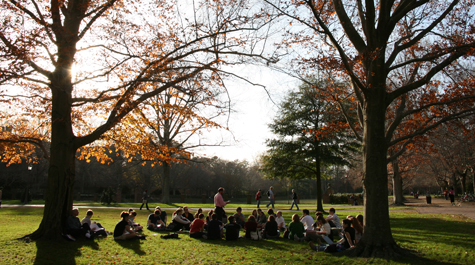Greenhouse gas emissions reduced 16% since 2002
William & Mary reduced its carbon emissions 16 percent per square foot of building space since 2002, according to the College's first official greenhouse gas inventory released this week.
The inventory, completed by Environmental Science & Policy Program Director and Biology Professor John Swaddle and Lauren Edmonds '11, points to efficiency improvements to the on-campus power plant as the largest source of greenhouse gas emission reductions. The inventory resulted from their work on the Committee on Sustainability (COS).
The reduction, which averages to 2.5 percent per member of the College community, is the latest item of good news in the ongoing efforts to improve environmental sustainability at the College.
"This is a trajectory that beats almost all the federal, state, and even international emissions reductions targets out there," Swaddle noted, citing the great efforts of his collaborators. "Lauren did a wonderful job of coordinating dozens of faculty, staff, and students to pull this information together, and Dan Patterson, our campus energy manager, deserves a hearty pat on the back for many of these improvements."
A year ago, President Taylor Reveley appointed COS, which is now made up of more than 130 faculty, staff, student and administrator volunteers in three subcommittees and 10 working groups. As co-chairs of COS's Science and Technical Advisory Committee (STAC), Edmonds and Swaddle were tasked in the fall of 2008 to create a model of the Williamsburg campus's greenhouse gas emissions. The report is the result of a year of collecting and analyzing emissions data on the College's fuel use, electricity use, travel, and waste. The information was analyzed using a modified database workbook created by the Intergovernmental Panel on Climate Change that was originally meant for nation-scale emissions data.
Patterson provided much of the data, which was split into three categories, or "scopes," based on institutional control over each set of emissions. By organizing emissions data into the three categories of produced energy, purchased energy, and emissions from transportation and waste, Edmonds and Swaddle hoped to gain more insight into increases and reductions in each category. Scope 1, covering direct emissions from on-campus boiler plants, saw the largest reduction over the audit's time scale. Much of the reduction can be attributed to large-scale facilities projects completed recently, Patterson said.
"The greatest improvements that have been achieved in the reduction of greenhouse gas emissions are due to the investments for utility infrastructure," he said. "Most notable were the abandonment of a high-temperature hot water loop and the creation of a central plant beneath Swem Library. This not only improved energy efficiencies but provided greater flexibility for the recent growth on the west side of the campus."
The largest source of the College's greenhouse gas emissions came from Scope 2, which contained purchased energy, most of which is provided by coal-fired power plants. These plants "emit the most CO2 per unit of electricity of any fuel source," Edmonds says, adding that large-scale emissions reductions will be difficult "without addressing these emissions by increasing our purchasing of clean energy or reducing our energy use greatly."
Patterson further added that Facilities Management continues to identify new projects that are innovative and cost effective in its effort to reduce greenhouse gas emissions.
"A significant area of opportunity for improving energy efficiency and reducing costs are building controls. Many of the existing buildings on campus use older technologies that waste energy and provide inadequate conditioning," Patterson said.
Swaddle emphasized the ability of individuals in the College community to create necessary changes. "We have to find ways to reduce our electricity use through both technological and efficiency improvements, but we also have to facilitate significant behavioral change."
He added, "If every member of our community turned on just half the lights in their office, unplugged their appliances when not in use, turned down the heat by two degrees in winter, and their AC cooling up by two degrees in summer, then we could collectively make a big difference as well as save a lot of money for the College."
The full report can be read here. To learn more about sustainability at W&M and the Committee on Sustainability, visit www.wm.edu/sustainability.
 Skip to main content
Skip to main content

